Metasurface CGH optimization for CTIS based on interior point method
IF 1.4
4区 物理与天体物理
Q3 OPTICS
引用次数: 0
Abstract
In the design of the Computed Tomographic Imaging Spectrometer (CTIS), in order to optimize the holographic grating and achieve better design performance, this paper proposes a novel optimization algorithm based on the Gerchberg–Saxton (GS) iterative algorithm. This algorithm combines the weighted GS algorithm with the interior point method (IPM). By introducing weight factors for phase and amplitude in the optimization process of the GS algorithm, and incorporating the actual diffraction characteristics of the holographic grating obtained from the Computer Simulation Technology Studio Suite into the IPM optimization process, a more optimized design performance is achieved. Using this algorithm, a metasurface holographic grating is designed, which can transform the input parallel light into a dispersion image of 25 diffraction orders on a focal plane array. The transmission efficiency exceeds 72%, and the root mean square error between different diffraction orders is less than 0.1. Among them, the optimization time is shortened by approximately 70% due to a significant reduction in the number of independent variables through symmetry. Through comparison, this method can further improve the uniformity of energy distribution based on the original algorithm, avoid being trapped in local extreme values, and thus enhance the overall design quality of the CTIS.基于内点法的 CTIS 元表面 CGH 优化
在计算机断层扫描成像光谱仪(CTIS)的设计中,为了优化全息光栅并获得更好的设计性能,本文提出了一种基于 Gerchberg-Saxton (GS) 迭代算法的新型优化算法。该算法结合了加权 GS 算法和内点法(IPM)。通过在 GS 算法的优化过程中引入相位和振幅的权重因子,并将从计算机仿真技术工作室套件获得的全息光栅的实际衍射特性纳入 IPM 优化过程,实现了更优化的设计性能。利用该算法,设计出了一种元面全息光栅,可将输入的平行光转化为焦平面阵列上 25 个衍射阶次的色散图像。其传输效率超过 72%,不同衍射阶数之间的均方根误差小于 0.1。其中,由于对称性显著减少了自变量的数量,优化时间缩短了约 70%。通过比较,该方法可以在原有算法的基础上进一步提高能量分布的均匀性,避免陷入局部极值,从而提高 CTIS 的整体设计质量。
本文章由计算机程序翻译,如有差异,请以英文原文为准。
求助全文
约1分钟内获得全文
求助全文
来源期刊

Laser Physics Letters
物理-仪器仪表
CiteScore
3.30
自引率
11.80%
发文量
174
审稿时长
2.4 months
期刊介绍:
Laser Physics Letters encompasses all aspects of laser physics sciences including, inter alia, spectroscopy, quantum electronics, quantum optics, quantum electrodynamics, nonlinear optics, atom optics, quantum computation, quantum information processing and storage, fiber optics and their applications in chemistry, biology, engineering and medicine.
The full list of subject areas covered is as follows:
-physics of lasers-
fibre optics and fibre lasers-
quantum optics and quantum information science-
ultrafast optics and strong-field physics-
nonlinear optics-
physics of cold trapped atoms-
laser methods in chemistry, biology, medicine and ecology-
laser spectroscopy-
novel laser materials and lasers-
optics of nanomaterials-
interaction of laser radiation with matter-
laser interaction with solids-
photonics
 求助内容:
求助内容: 应助结果提醒方式:
应助结果提醒方式:


